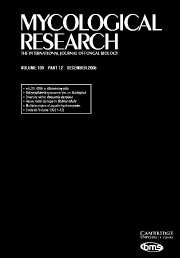Article contents
Fungitoxicity of oxine and copper oxinate: effectsof pH, metals and chelating agents on activity
Published online by Cambridge University Press: 01 September 1999
Abstract
Oxine and copper oxinate have along history of use as fungicides. Ability to chelate and lipophilicity have been regarded asessential to the action of oxine. The most widely held hypothesis on the mechanism of action of oxineholds that oxine is only active when it can form saturated chelates with metals in the medium whichenter the cell and dissociate to liberate a toxic half-chelate. Metals, chelating molecules and pHwere investigated for their effect on the fungitoxicity of oxine and copper oxinate. Oxinefungitoxicity increased with increase in medium pH, inhibitory activity corresponding most closelywith the concentration of the neutral species. Chelation of oxine with metals in the medium was foundnot to be a requirement for oxine fungitoxicity. Potentiation of the action of oxine by metals isexplained by the formation of more fungitoxic and soluble metal oxinates and antagonism by theformation of less soluble or less active metal oxinates. Chelating amino acids, nucleic acid bases andEDTA did not antagonize oxine fungitoxicity. Antagonism by riboflavin and folic acid suggestsinteraction of oxine with specific cellular functions in fungi. The fungitoxicity of copper oxinatewas generally not affected by metals, chelating molecules or changes in medium pH. It is proposed thatthe data support the inherent fungitoxicity of oxine, the role of metal oxinates as co-toxicants andindependent mechanisms of action for oxine and copper oxinate.
Information
- Type
- Research Article
- Information
- Copyright
- © The British Mycological Society 1999
- 11
- Cited by

